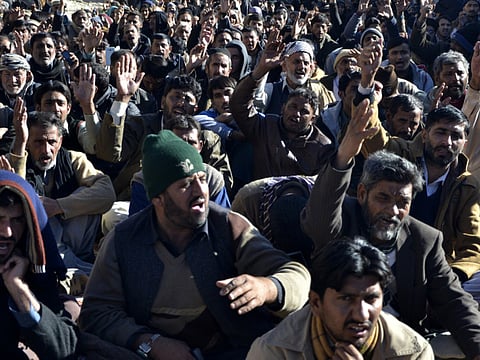Iran recruits Pakistani Shiites for combat in Syria
Zeinabiyoun logo is fist holding a machine gun set in green and yellow similar to Hezbollah emblem

Beirut: For years, websites linked to Iran’s Revolutionary Guard have posted articles eulogising Shiite fighters who die in Syria. But two men heralded last month for dying to defend a shrine near Damascus were different from most martyrs given such treatment in the past: they were Pakistanis.
The men were part of the Zeinabiyoun, a unit of Pakistani fighters named for a granddaughter of Prophet Mohammad (PBUH) buried in the shrine, the latest contingent in an Iranian drive to recruit Shiites from the region to fight in Syria.
The increase in the number of “martyrdom” notices of fighters from the group this year indicates they are taking a more active role in the conflict. A posting in mid-November on a Twitter account bearing the group’s name displayed the pictures of 53 men, described as fighters killed in battle.
While there has been no official announcement of their total numbers, a regional source familiar with the issue said there were hundreds of Pakistanis fighting in Syria.
Iran’s recruitment of the Pakistani fighters adds yet another international dimension to Syria’s 4-year-old civil war, which has deepened sectarian divisions across the Muslim world and drawn in most regional and global powers.
The Pakistani Shiites are helping to defend the government of Tehran’s ally, President Bashar Al Assad, who is also supported by Russian air strikes and fighters from Lebanon’s Hezbollah militia, against an array of Syrian rebels backed by Turkey and Arab states. A Facebook page bearing the name of the Zeinabiyoun showed pictures of what was described as a funeral in Iran in late November, with members of Iran’s Revolutionary Guard standing next to men in shalwar kameez, the traditional long tunic and trousers worn in Pakistan.
“The Zeinabiyoun are a Pakistani Shiite outfit that’s run by the IRGC,” said Phillip Smyth, a researcher at the University of Maryland and adjunct fellow at the Washington Institute for Near East Policy who has done extensive research on Shiite groups fighting in Syria, using an acronym to refer to Iran’s Islamic Revolutionary Guard Corps.
“They’ve put together their own imagery, their own recruitment type material. They really became more of a marketable element toward the end of the summer of 2015. That’s when they became more of a centred group.”
Although the vast majority of Pakistanis are Sunnis, the country is home to millions of Shiite Muslims, making it among the biggest Shiite communities in the world.
“There is a large pool to draw from,” said Alex Vatanka, a senior fellow at the Middle East Institute in Washington and the author of a book on relations between Pakistan and Iran.
“There are pockets within that Shiite community that have been willing to pick up arms to fight for their Shiite identity, their sectarian identity. And that’s what the IRGC is tapping into.” They are only the latest Shiites recruited by Iran to fight in Syria, after Hezbollah fighters from Lebanon, members of Iraq’s Shiite majority and members of Afghanistan’s ethnic Hazara Shiite minority. All have been deployed to support Al Assad, whose own Alawite sect is an offshoot of Shiite Islam.
Videos and pictures posted on social media sites say Zeinabiyoun fighters have been active around Aleppo as well as at the shrine near Damascus in the last month.
Based on material posted online, the Zeinabiyoun could have up to 1,000 fighters, estimated Smyth.
Attempts to get comment from a public relations news office of the Revolutionary Guard were unsuccessful.
The Zeinabiyoun have drawn on the symbols of their fellow Shiite fighters to brand themselves: their logo, a fist holding a machine gun set in green and yellow, is an almost identical copy of that of Lebanon’s Hezbollah. They are occasionally referred to as Hezbollah Pakistan online.
The group is open about its affiliations: its Facebook pages praise Iranian Supreme Leader Ayatollah Ali Khamenei and talk about a sense of duty to defend the Sayyida Zeinab shrine.
“The message Iran is recruiting with, like it or not, is a sectarian message,” said Vatanka. “That is a message that is inherently dangerous and can get out of hand.” According to the group’s postings on the internet, some of the Pakistanis fighting in Syria were already residing in Iran, while others come from a community of Pashtun Shiites in the town of Parachinar in the Pakistani tribal areas.
The Zeinbayioun started out as part of a unit of Afghan fighters called the Fatemiyoun, Smyth said. The Fatemiyoun have taken heavy losses in Syria and there are regular postings about their casualties on hardline Iranian sites.
At least some of the Afghan fighters have been lured to fight through promises of Iranian citizenship or steady monthly income. Advertisements aimed at Pakistanis online suggest similar inducements.
One recruitment ad posted on Facebook last week said any physically fit man between 18 and 35 should apply to fight in Syria. It offered 45 days of initial military training along with six months of further training in Syria, a salary of 120,000 Pakistani rupees (approximately $1100) per month and 15 days of holiday every three months.
If the recruit is killed in action, his children’s education will be paid for and the family will be given pilgrimage trips to Iran, Iraq and Syria every year. Any willing recruits should make their way to Iran’s holy city of Qom, the ad said.
Sign up for the Daily Briefing
Get the latest news and updates straight to your inbox


